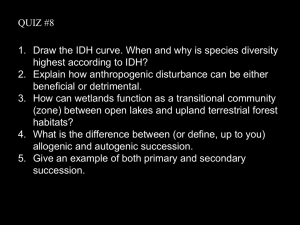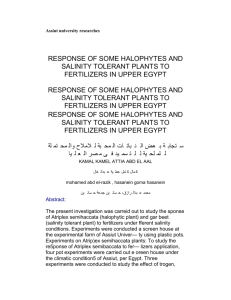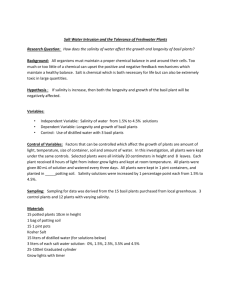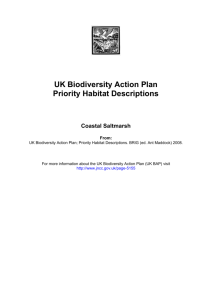HW Saltmarsh succession challenge
advertisement
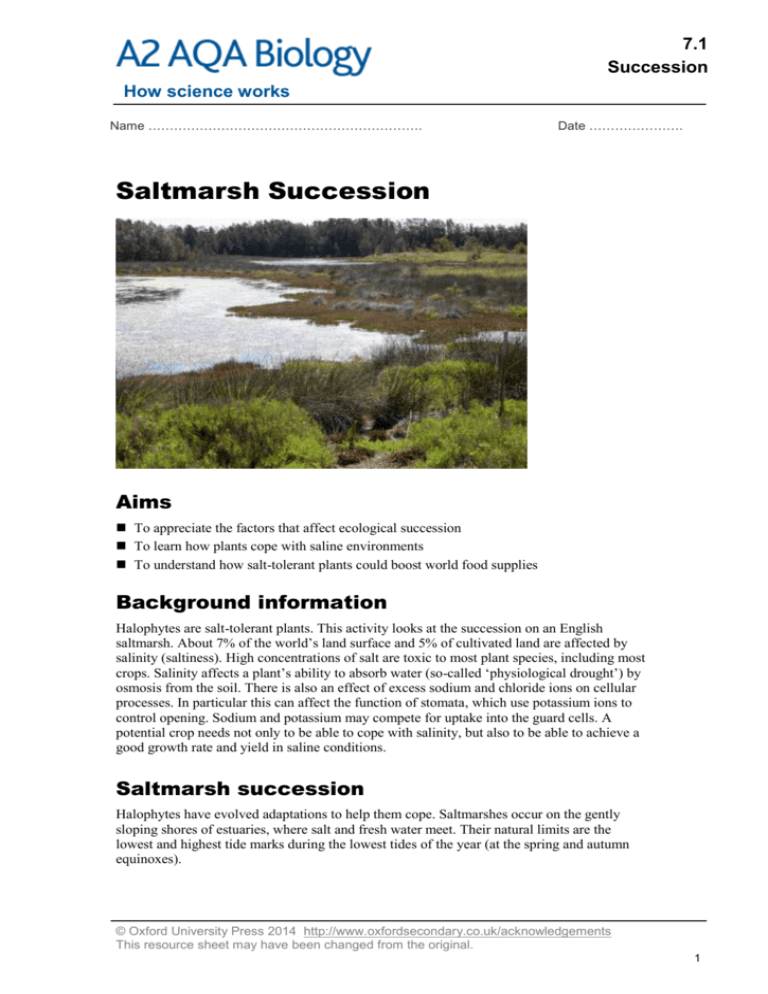
7.1 Succession How science works Name ………………………………………………………. Date …………………. Saltmarsh Succession Aims To appreciate the factors that affect ecological succession To learn how plants cope with saline environments To understand how salt-tolerant plants could boost world food supplies Background information Halophytes are salt-tolerant plants. This activity looks at the succession on an English saltmarsh. About 7% of the world’s land surface and 5% of cultivated land are affected by salinity (saltiness). High concentrations of salt are toxic to most plant species, including most crops. Salinity affects a plant’s ability to absorb water (so-called ‘physiological drought’) by osmosis from the soil. There is also an effect of excess sodium and chloride ions on cellular processes. In particular this can affect the function of stomata, which use potassium ions to control opening. Sodium and potassium may compete for uptake into the guard cells. A potential crop needs not only to be able to cope with salinity, but also to be able to achieve a good growth rate and yield in saline conditions. Saltmarsh succession Halophytes have evolved adaptations to help them cope. Saltmarshes occur on the gently sloping shores of estuaries, where salt and fresh water meet. Their natural limits are the lowest and highest tide marks during the lowest tides of the year (at the spring and autumn equinoxes). © Oxford University Press 2014 http://www.oxfordsecondary.co.uk/acknowledgements This resource sheet may have been changed from the original. 1 7.1 Succession How science works Figure 1 A typical plant succession on an English saltmarsh At the lower end of the marsh, waterlogging and instability of the soil cause problems for plants. Waterlogging causes lower oxygen levels in the soil and a high level of salinity. Lower light levels, while they are submerged, is also a problem to which plants have adapted. The middle levels of the marsh will suffer considerably from wave action (the lowest levels will be less affected by this as they will be submerged for much more of the time). Soils will not have time to dry out as much as the upper levels, so extremes of salinity may not be so great here. At the upper levels of the saltmarsh, evaporation rates are high, as they are more exposed to the wind and rain. Salinity will fluctuate as the soil will be flushed by heavy rain (fresh water). Temperature fluctuations will also be more extreme, since temperatures will be reduced while submerged at high tide, but increased at low tide. At, and beyond, the upper limit of the marsh, a salt-tolerant grassland dominated by saltmarsh grass (Puccinellia maritima) develops, and is often grazed by sheep or horses. Plants adapted to growing in a saltmarsh must be able to tolerate the environment described above. But first they must get there, so seed dispersal, and the ability to germinate in unstable soil that is waterlogged and saline all the time, is important. Plant root systems help to stabilise the mud and encourage further deposition of silt which builds up the soil level, allowing other species to thrive. As the plants die and decay, they add organic material (humus) and minerals to the soil. Later in the succession they will also provide shade and © Oxford University Press 2014 http://www.oxfordsecondary.co.uk/acknowledgements This resource sheet may have been changed from the original. 2 7.1 Succession How science works shelter for the seedlings of other species. Plants which follow in the succession need to be able to cope with more shading and competition for nutrients and minerals in the soil. Saltmarsh species differ in the depth and spread of their root systems. Some, such as sea lavender (Limonium), have very deep roots that avoid surface competition. As the height of the marsh increases, there is a reduced frequency of flooding and of wave action, but an increased exposure to sun, wind and rain. There is also a reduction in water content of the soil and an increase in the content of organic matter. This leads to a variety of halophytes that are adapted to salinity. Adaptations to salinity Most halophytes are either salt tolerators or salt avoiders. Salt tolerators have physiological and biochemical adaptations for keeping their metabolism working despite accumulating salts in their cells. They tend to keep salt in particular compartments of the cells, such as the vacuole. This involves genes that control the actions of protein channels/transport proteins in membranes. Certain alleles may be activated by salt stress. Salt avoiders have structural adaptations to minimise salt concentration in their cells, to prevent salt uptake by the roots, or to get rid of salt by excreting it through special glands on their leaves, where it is washed away by rain. Halophytes like cordgrass (Spartina) and sea lavender (Limonium) actively excrete salt through special salt glands on the surface of the leaves. The salt is washed away by rain. The leaves of some Limonium species can excrete up to half their weight in salt in 24 hours. Some plants produce chemicals (‘osmoprotectants’) in their cell sap that lower their water potential so that they can still take up water by osmosis. This helps to protect cellular structures such as chloroplasts and prevents macromolecules being deformed by water stress. Others control the water content of their tissues, either by becoming succulent, or by changing the numbers of water-forming channels (aquaporins) in cell membranes and perhaps by adaptations in their ability to control water movement in or out of cells. Succulents have the added advantage of a reduced surface area, which reduces water loss by transpiration and evaporation. An example of this is the pioneer species glasswort (Salicornia). Some halophytes actually take in salt to reduce water potential. These ions are usually stored in the vacuole so that they do not interfere with cell metabolism. A few species accumulate salt in their leaves, then shed them from time to time. Some genes affect the loading of sodium into the phloem in roots and shoots. Certain alleles can discourage loading of salt into the phloem at the roots, so keeping the root sodium content high for water uptake, but preventing the shoot tissues being exposed to too much sodium. The seeds of some halophytes remain dormant in very salty conditions, but break dormancy when conditions become less salty, for example, after heavy rain. This ensures the seeds germinate when conditions are favourable for the uptake of water by the embryo. Many halophytes actually grow better in non-saline conditions, but they are at a great competitive advantage in saline conditions. © Oxford University Press 2014 http://www.oxfordsecondary.co.uk/acknowledgements This resource sheet may have been changed from the original. 3 7.1 Succession How science works Questions 1 What are the most challenging environmental factors for plants at: a) the lower part of a saltmarsh b) the middle of a saltmarsh c) the top of a saltmarsh? 2 What features make a plant a good coloniser of bare mud? 3 How do plants at the lower end of the marsh change conditions so that the habitat becomes more favourable for other plants to invade? 4 The frequency of different species changes as you progress up the marsh. How would you sample a saltmarsh to get reliable figures for the changing frequency of the different species in relation to elevation above sea level? 5 How do several different species manage to coexist at the same level of a saltmarsh? 6 Compare species in the early and late stages of saltmarsh succession. What environmental factors vary at the different levels? Take into account seed dispersal and germination, the relationship between photosynthesis and light intensity, respiration rates, transpiration rate, and stomatal behaviour. 7 How can saltmarshes protect the coast? Why might this be better than sea walls or dykes? 8 a) What metabolic/physiological processes are involved when plants excrete excess salts? b) How can plants prevent salts from damaging cell components? c) What adaptive features of halophytes might be under genetic control? 9 Considering the practical and economic advantages and disadvantages, which do you think would be most successful, genetically engineering existing crops to tolerate saline soils, or developing new crops from existing halophytes? Sources The background information will give you some ideas. You will find information on the basic science in Oxford University Press A2 Biology Chapter 7.1 Ecological succession. You may also find Oxford University Press AS Biology Chapter 3 (Cells and movement in and out of them) useful. © Oxford University Press 2014 http://www.oxfordsecondary.co.uk/acknowledgements This resource sheet may have been changed from the original. 4


